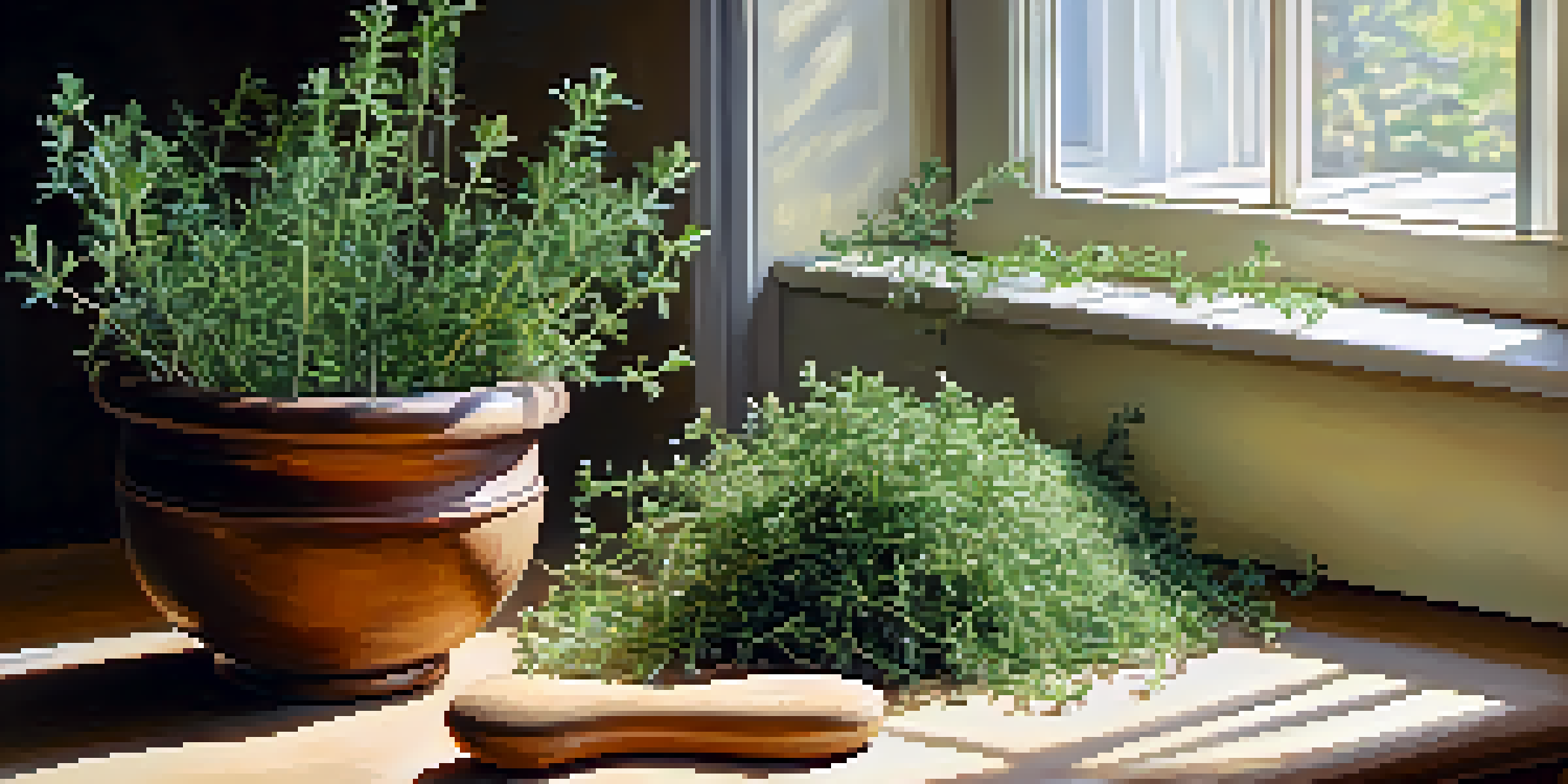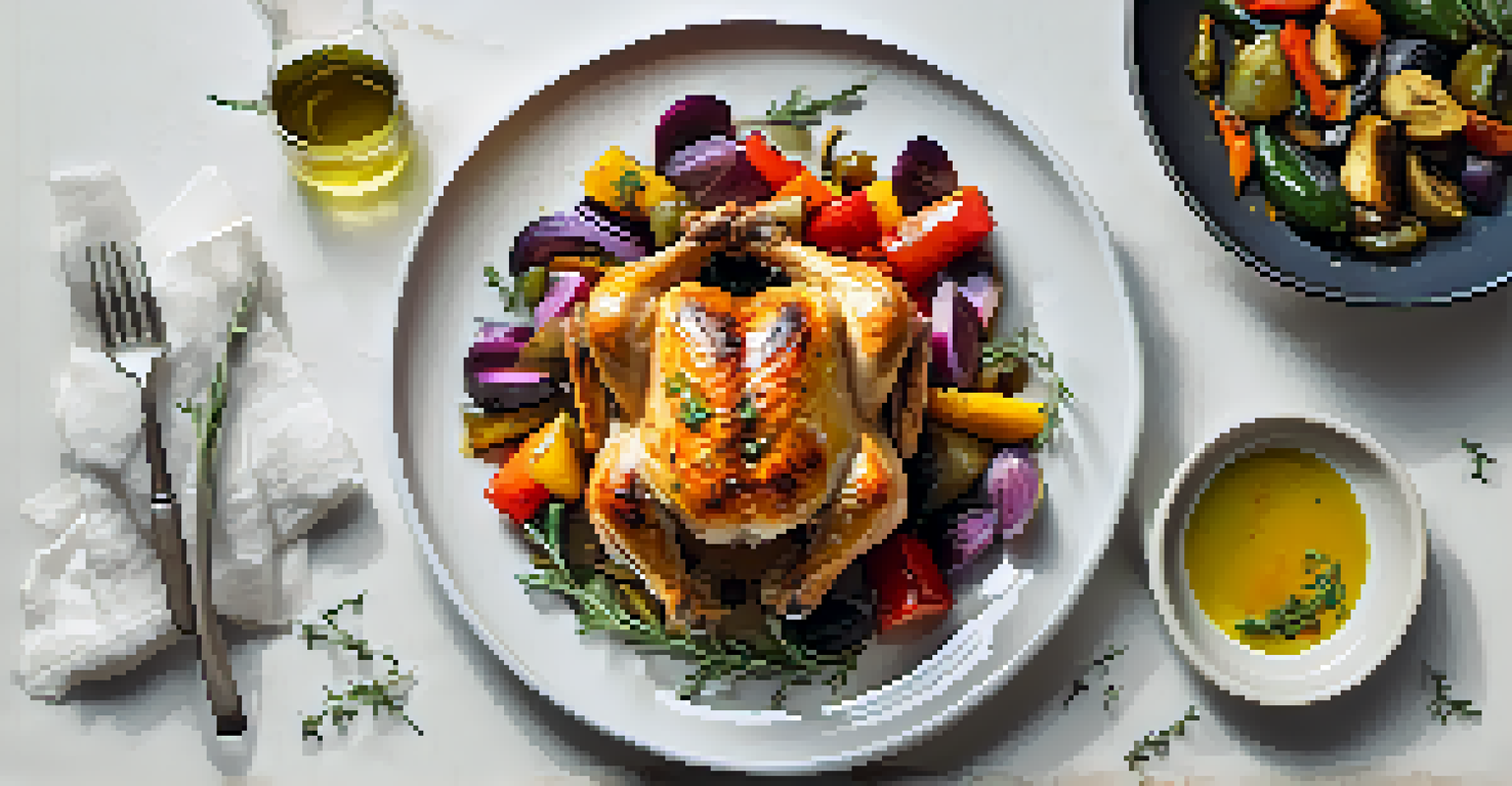Thyme in the Kitchen: Flavor Enhancement and Health Benefits

Introduction to Thyme: A Culinary Staple
Thyme is a fragrant herb that has been used for centuries in cooking. Its earthy, slightly minty flavor makes it a beloved addition to many dishes, from roasted meats to hearty soups. In the kitchen, thyme not only enhances taste but also brings a host of health benefits.
Herbs are the friend of the cook, and the best kind of flavoring you can add to your food.
Often overlooked, thyme can transform an ordinary meal into something truly special. Whether fresh or dried, this versatile herb can be used in a variety of cuisines, adding depth and complexity to your favorite recipes. Think of thyme as the secret ingredient that ties everything together.
In this article, we will explore how thyme can elevate your cooking and contribute to your well-being. We'll uncover its flavor profile, culinary uses, and the health benefits that make it a must-have in any kitchen.
Flavor Profile: What Makes Thyme Unique
Thyme has a unique flavor that can be described as earthy, slightly minty, and somewhat lemony. This complex profile allows it to complement a wide range of ingredients, from savory meats to fresh vegetables. When cooked, thyme’s flavor deepens, creating a warm, inviting aroma in your dishes.

The herb's versatility means it can shine in a variety of cuisines, whether it’s Mediterranean, French, or even American. A sprinkle of thyme can elevate a simple tomato sauce or enhance the flavors of roasted chicken and potatoes. It’s like adding a touch of magic to your meals.
Thyme: A Flavorful Culinary Herb
Thyme adds a unique earthy, minty flavor to a variety of dishes, enhancing their overall taste.
Additionally, thyme works well with other herbs and spices, making it an excellent choice for herb blends. Pair it with rosemary, garlic, or oregano to create mouthwatering marinades or dressings that will leave your guests asking for the recipe.
Cooking with Thyme: Tips and Techniques
When using thyme in your cooking, it’s essential to know when to add it for the best flavor. For dishes that simmer for a long time, such as stews or soups, adding thyme early on allows its flavor to meld with the other ingredients. In contrast, for lighter dishes, like salads or roasted vegetables, add fresh thyme just before serving to retain its vibrant taste.
Thyme is the easiest herb to grow and the most useful in the kitchen.
Fresh thyme can be used whole, while dried thyme should be crumbled to release its oils and flavors. If you're using fresh thyme, remember to strip the leaves from the stems before adding them to your dish. The stems can be tough and woody, so it's best to leave them out.
Experimenting with thyme can be a delightful culinary adventure. Try infusing olive oil with thyme for a flavorful drizzle over grilled vegetables or mixing it into your favorite vinaigrette for a fresh twist.
Health Benefits of Thyme: More Than Just Flavor
Thyme isn't just a flavor powerhouse; it also boasts numerous health benefits. This herb is rich in antioxidants, which help combat oxidative stress in the body. Incorporating thyme into your diet can support overall health and well-being, making it a valuable addition to your meals.
Thyme has been shown to have antimicrobial properties, which can help fight off harmful bacteria and viruses. This makes it a great choice for boosting your immune system, especially during cold and flu season. Think of thyme as a natural defender for your body's health.
Health Benefits of Thyme
Rich in antioxidants and antimicrobial properties, thyme supports overall health and boosts the immune system.
Moreover, thyme is known to aid digestion and can even help alleviate respiratory issues. A cup of thyme-infused herbal tea can provide soothing relief for a sore throat, proving that this herb is not only delicious but also beneficial for your health.
Thyme in Herbal Remedies: A Historical Perspective
Historically, thyme has been used for its medicinal properties since ancient times. The Egyptians used it during the mummification process, while the Greeks believed it to be a source of courage and strength. This rich history underlines the herb's significance beyond the kitchen.
Traditional herbalists often recommend thyme for treating respiratory issues, digestive problems, and even as a natural remedy for anxiety. Its calming aroma can promote relaxation, which is why many people enjoy thyme in aromatherapy or herbal teas.
Incorporating thyme into your health regimen can be as simple as brewing a cup of thyme tea or using thyme essential oil in a diffuser. These practices connect us to the historical roots of this remarkable herb while enhancing our modern wellness routines.
Popular Thyme Varieties: Choosing the Right One
There are several varieties of thyme, each with its unique flavor profile and culinary uses. Common thyme, also known as English thyme, is the most widely used and has a robust flavor perfect for savory dishes. Meanwhile, lemon thyme adds a citrusy zing that can brighten up salads and seafood.
Another popular variety is creeping thyme, which is often used as a ground cover in gardens. Its strong flavor makes it suitable for culinary use as well, particularly in Mediterranean dishes. Understanding the different types of thyme can help you choose the right one for your cooking needs.
Historical Uses of Thyme
Historically valued for its medicinal properties, thyme has been used since ancient times for various health remedies.
When selecting thyme, consider whether you want fresh or dried. Fresh thyme is often more flavorful, while dried thyme offers convenience and a longer shelf life. No matter which variety you choose, incorporating thyme into your meals will undoubtedly enhance their taste.
Conclusion: Embrace Thyme in Your Cooking Journey
Incorporating thyme into your kitchen is a simple yet effective way to elevate your meals and improve your health. From its unique flavor profile to its impressive health benefits, thyme is a versatile herb that deserves a spot in your pantry. Whether you're a seasoned chef or just starting out, thyme can enhance your culinary creations.
As you experiment with thyme in your cooking, remember to be creative! Use it in marinades, dressings, or even as a garnish to add a touch of sophistication to your dishes. You might be surprised at how much a little thyme can transform your meals.

So, the next time you're in the kitchen, don't forget about thyme. Embrace its flavor and health benefits, and let it inspire you to create delicious, wholesome meals that nourish both your body and soul.